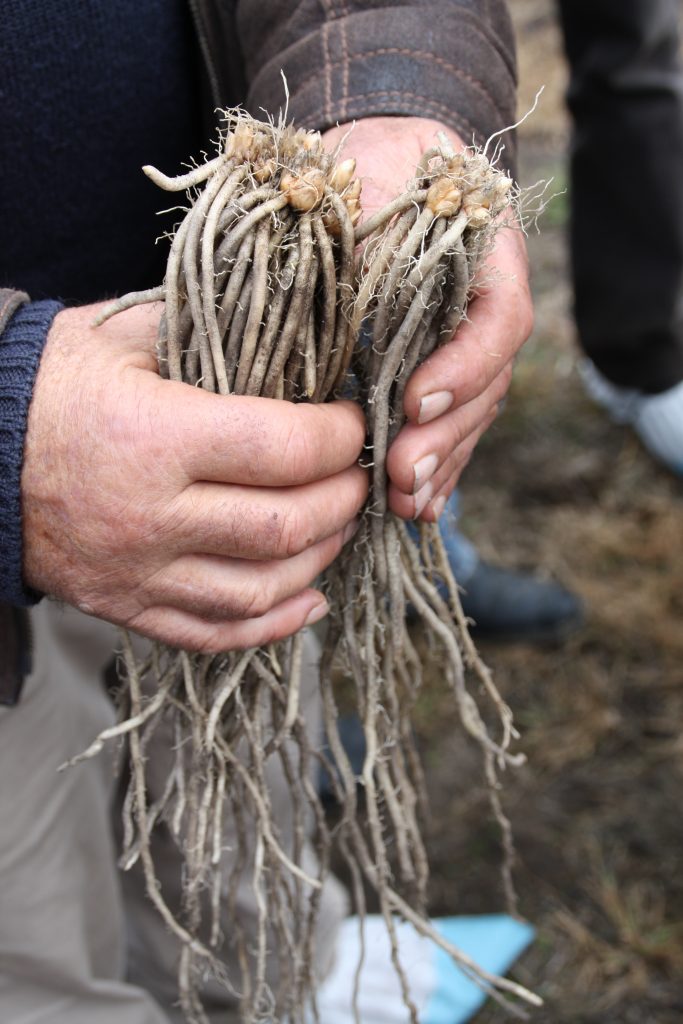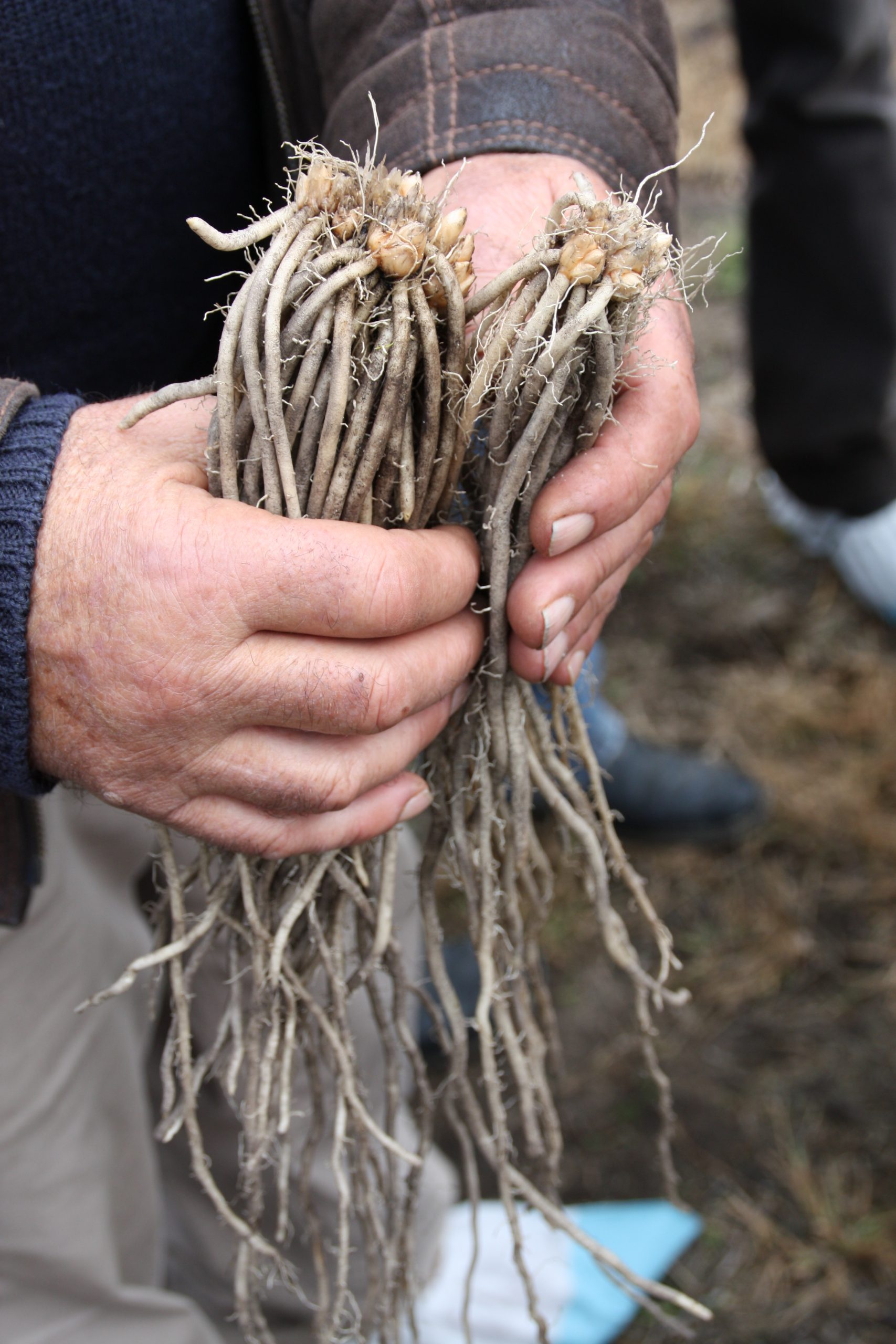How to achieve a good plantation
An asparagus bed can be established using different parts of the asparagus: the transplant seedling, the crown and the seed. However, it is quite rare to see crops set up from seed. This technique was first developed in Peru. Some examples can be found in green asparagus crops in the United States and in white asparagus in Germany.
Several categories depending on the weight of the crown
While the low cost of seed reduces the expenditure required to establish the crop, it is expensive and difficult to control germination and then breeding and maintenance of the crop before the first harvest. The seedling and the crown are therefore the essential bases of asparagus cultivation around the world. In both cases, the plant material used combines the genetic potential of the variety (contained in the seed – most varieties are hybrids) and the vegetative potential of the plant. The seedling and the crown are therefore the result of combining the breeder’s and the nursery’s creativity. Seedlings are mainly used in South America, Asia and southern Italy for green asparagus, and sometimes in Spain for white asparagus. The mini-plug plant offers an alternative to the transplant seedling, the only variation being the volume of soil used. The crown is mainly used in Europe. Although the current EU regulations require a minimum weight of 25g, the asparagus crowns typically supplied to professionals weigh at least 40g. Some nurseries even offer several categories depending on the weight of the crown (e.g. 40-70g and 70g+, corresponding to categories A and A+).
The planting process varies depending on whether a plant or a crown is used. In the case of a crown, the first phase of breeding lasts one year and is entrusted to a nursery (see box). The plant material is then planted by the asparagus producer. The crown constitutes “dormant plant material.” In the first year, the plant develops its foliage. The crown grows and then accumulates reserves at the end of its vegetative cycle (autumn). In the year after planting, a first harvest of 25% of the asparagus’ potential is possible. Then, the foliage must be allowed to grow again. In “planting year +2″, the harvest reaches 50% of the potential. Thanks to its accumulated reserves, the crown makes it easy to establish an asparagus bed and then for the transplant to take. Using a crown, the time spent maintaining the plot (irrigation, weeding) is shorter before the first harvest. On the other hand, the additional cost of the crown means an increase in plant investment (about +30% compared to the seedling).
More Info
Transplanting requires greater technical skill
A transplanted seedling is put in place a few months after the seed is sown, using “living plant material”. It is therefore important to plan to introduce water as soon as the seedling is planted. A seedling can be planted later than a crown can. In some cases, it is even possible to collect a very early harvest from the old asparagus bed before replanting. The year of planting is reserved for the development of the seedling (crown and foliage).
“Planting year +1” is also reserved for the growth of the crown. Indeed, it is difficult to envisage a harvest, even a partial one, except for early, well-established plantations. The harvest in “planting year + 2” yields 50% of the production potential. Transplanting a seedling requires a greater level of technical skill and closer monitoring of the crop than is required when transplanting a crown. However, the actual planting is easier as it is possible to see the seedlings, while the crowns are buried in the soil. However, eventually the roots of the transplanted seedlings go deeper into the soil to explore a larger area. The purchasing price is lower for seedlings. On the other hand, in the first year after planting seedlings, the asparagus producer essentially becomes a crown producer. This requires precise control of irrigation and especially careful weeding. Therefore, the money gained from adopting the seedling technique must be invested in maintaining the crop. Moreover, the “non-productive period of the lot” lasts for an additional year, which implies additional land costs.
Transplanting: raising the plant before harvesting
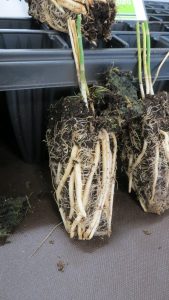
The transplant option involves planting plug plants from the seedlings of a given year between June and September. The main advantage of this method is that it compensates for a lack of crown availability. The technique might also make it easier to choose the variety or to order plants later. What’s more, the plug allows planting while in growing conditions. It can also make it easier to plant in heavy soil. In terms of organisation, the gap between harvest and planting allows producers to make best use of their workforce. But the time savings during the planting year are offset by the additional year required to maintain the asparagus. More precise monitoring of irrigation is required to ensure the plug takes as it has lower reserves than a crown does. Some nurseries supplying transplants offer several types of plugs. Care must be taken to ensure that the roots of plug plants do not accumulate or “bunch-up” and they keep their swivel character to facilitate their development.
More Info
Crowns are cultivated by specialists
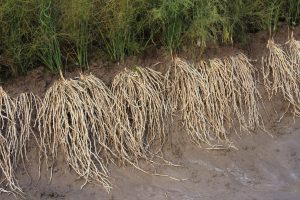
Crown production is carried out in soils that are free of disease (e.g. Purple Rhizoctone and Fusariasis). These are either new soils that have never received asparagus or are long-rotating soils (more than 6 to 7 years) that have previously been disinfected. Seeding in March is carried out at a density of 220,000 to 260,000 seeds/ha, depending on the richness of the soil, the calibres of crowns sought, and whether the varieties produce larger or smaller crowns. The germination rate is quite low (75 to 95%) and germination time is long. Therefore, control of weeds is required in the nursery. This is carried out using pre-lift herbicides followed by mechanical weeding between rows and manual weeding on the rows. The process is repeated every month as competition from weeds severely penalises the growth of asparagus and thus the calibre of the crowns. Plant protection is applied and monitored closely to prevent any disease or pest harming the foliage. Crowns are collected in February and March before the vegetation is thinned out. Depending on the customers’ requests, this may involve grubbing and direct delivery or refrigerated storage of crowns (for no more than a month) prior to shipment. The grubbing of crowns requires the use of specific equipment, which is available to European and US nurseries. This decisive step in crown production justifies the development of transplants in some countries. The crowns are soaked in an anti-fungal treatment, except in the case of organic crowns for organic plants.
More Info
Choosing a good crown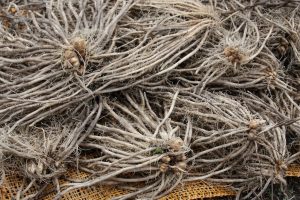
A crown’s calibre is a predictor of the energy it will have to help it to establish itself and ensure the emergence of stems. Every bit as important as the weight of the crown itself is the regularity of the weight among a batch of crowns as uniformity assists planting (especially with high densities) and ensures the homogeneity of the plot to come. The crown consists of a tray and a system of fleshy roots that make up the plant’s reserves. Look for a spread, balanced tray to facilitate its future development, as well as a significant number of spear buds, on average 5 to 7 (variable depending on the variety). This number is an indicator of the number of stems that will emerge. Plenty of vegetation in the first year will ensure good implantation of the asparagus. Stocky crowns can also facilitate machine planting and/or positioning during high density planting (8 to 9 crowns per linear metre).
7 tips for planting
1 Order the crowns one year before planting to make sure you have the desired variety and quantity. Ordering a transplant requires about 4 months’ delivery time.
2 Anticipate and plan ahead when planting as it may require preparatory work such as the opening of trenches and possibly the drainage, de-compaction, sub-soiling, addition and incorporation of organic matter and/or dressing manure. Soil disinfection and the destruction of perennials may also be necessary.
3 Upon taking delivery of the crowns, if the batches are heterogeneous, it is important to sort the crowns according to their calibre to avoid competition that could prove fatal for the smallest crowns, which might wither within a few years (2 to 3 years) after planting.
4 Store the crowns in a well-ventilated and dry shed by spreading the bags (de-palletised), or in a cold chamber (2-5 degrees Celsius). They can be kept for 5 to 7 days under these conditions. Transplants should be kept outside and the hygrometry of the plug should be maintained.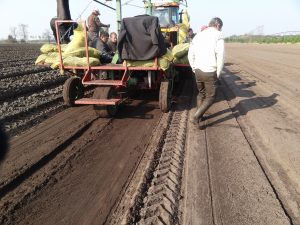
5 Plant crowns or seedlings as soon as possible. It’s best to plant warm plants in warm soil.
6 Aim to plant in good conditions. Allow the soil to dry up if there has been too much rain or wait for it to warm up if it has been too cold. Planting/establishing the crop is a key step in the subsequent performance of the asparagus throughout its entire production period (8 to 15 years).
7 Soak transplants and crowns in humic acid and/or mycorrhizae solutions to improve establishment and to provide health protection against Fusarium, Erwinia and Phytophthora.






